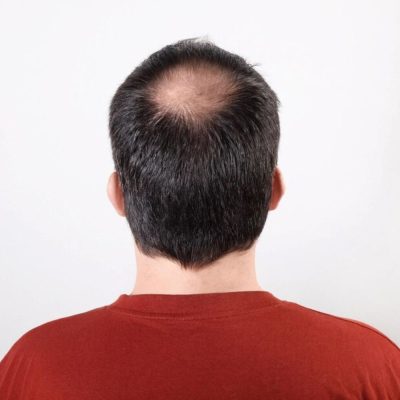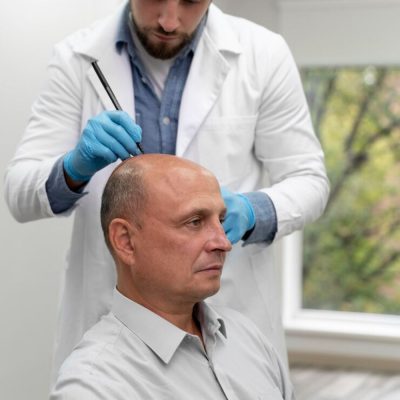Male Pattern Hair Loss
Male pattern hair loss is also called Androgenetic alopecia. It is the most common form of hair loss in men, affecting millions worldwide. It is characterised by a gradual thinning of hair on the scalp, often progressing to partial or complete baldness. At SkinAccess Clinics, we provide an expert diagnosis of male pattern hair loss and offer personalized solutions to help men regain a healthy head of hair, boosting their confidence and self-esteem.

What is Male Pattern Hair Loss?
Male pattern hair loss is a genetic condition typically beginning during the last 20s or early 30s. Its progression is usually slow over time, with the rate and extent of hair loss varying from individual to individual. It primarily affects the top and front of the scalp, leading to a characteristic pattern of hair thinning and baldness.
Symptoms of Male Pattern Hair Loss
Symptoms are distinctive and usually follow a predictable pattern
Receding Hairline
A receding hairline is one of the earliest signs, particularly at the temples, creating an “M” shape.
Thinning on the Crown
Hair thinning often occurs at the crown of the head, which may gradually expand, leading to a bald spot.
Bald Patches
Over time, the thinning areas on the temples and crown may merge, leading to a larger bald patch.
Overall Thinning
At times, hair thinning may occur evenly across the scalp, leading to diffuse thinning rather than distinct bald spots.
Causes of Male Pattern Hair Loss
Male pattern hair loss is primarily driven by two factors
It is a hereditary condition, which means it can be passed down from either parent. If an individual has close relatives with male pattern hair loss, he is more likely to develop it himself.
Male pattern hair loss is closely linked to the hormone dihydrotestosterone (DHT), a derivative of testosterone. DTH binds to hair follicles, causing them to shrink and produce thinner, shorter hairs. Over time, this can lead to the follicles becoming dormant and ceasing hair production altogether.

Diagnosis of Male Pattern Hair Loss
Male pattern hair loss is diagnosed by a dermatologist after a detailed assessment. This may include
Physical Examination
The scalp is examined to assess the pattern and extent of hair loss.
Medical History
A medical and family history helps to determine the likelihood of androgenetic alopecia.
Trichoscopy
A special device is used to examine the hair and scalp more closely, helping to confirm the diagnosis.
Scalp Biopsy
In rare cases, a scalp biopsy may be performed to rule out any other condition that could cause hair loss.
Management and Treatment of Male Pattern Hair Loss
While there is no cure for male pattern hair loss, there are several treatment options that help manage the condition and promote hair regrowth. SkinAccess Clinics offers a variety of treatments tailored to your specific needs.
➥ Topical Treatments: Minoxidil is a topical solution that when applied directly to the scalp, helps stimulate hair growth and slow down hair loss.
➥ Oral Medications: Medications containing finasteride are effective in preventing further hair loss and promoting regrowth by inhibiting the conversion of testosterone to DHT, thereby reducing hair loss.
➥ Hair Transplant Surgery:
- Follicular Unit Extraction (FUE): It involves individually removing hair follicles from the donor area and transplanting them to the thinning or balding areas. It is a minimally invasive procedure with a short recovery time and good outcomes.
➥ Platelet-Rich Plasma (PRP) Therapy: PRP involves injecting platelet-rich plasma (derived from the patient’s blood) into the scalp. The growth factors in PRP help stimulate hair follicles and encourage hair regrowth.
➥ PDO Threads: PDO threads can activate and stimulate the cells within the hair follicles. They encourage cell division and proliferation, promoting the growth of new hair strands. This activation of dormant follicles and the stimulation of cellular activity contribute to the overall restoration of hair. It is most effective for early to moderate stages of hair loss.
➥ Lifestyle & Hair Care Modifications:
- Gentle Hair Care: The use of mild shampoos and avoiding harsh treatments can help maintain scalp health and prevent further hair loss.
- Healthy Diet: A balanced diet rich in vitamins and minerals, can help support good hair health.
Conclusion
Male pattern hair loss is a very common condition and is a natural part of ageing for many men. However, with the right treatment and care, it is possible to manage hair loss and regrow hair. At SkinAccess Clinics, we are committed to providing you with the appropriate care and treatment plans to best suit your needs. Schedule a consultation with us today to explore your treatment options and take the first step toward restoring your hair and confidence!
